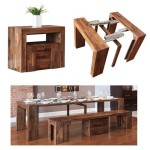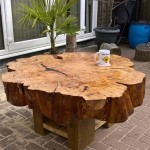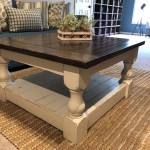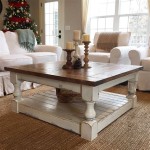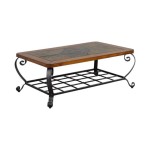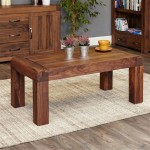What Size Coffee Table For a 90-Inch Sofa?
Selecting the appropriate coffee table size for a 90-inch sofa is a crucial element in achieving a balanced and functional living room. The coffee table serves not only as a surface for placing drinks, books, and decorative items, but also as a visual anchor that ties the seating arrangement together. A coffee table that is too large can overwhelm the space and impede movement, while one that is too small can appear insignificant and fail to provide adequate functionality. Determining the ideal size involves considering the dimensions of the sofa, the layout of the room, and the intended use of the coffee table.
The length, width, and height of the coffee table each play a distinct role in its overall suitability. The length should be proportional to the sofa's length, while the width should allow for comfortable passage around the table. The height should be conducive to easy access for placing and retrieving items while seated on the sofa. Failing to consider these dimensions can result in an aesthetically displeasing and functionally inadequate piece of furniture. Therefore, a careful evaluation of these factors is essential before making a purchase.
Beyond the practical considerations, the coffee table also contributes significantly to the overall style and ambiance of the living room. The choice of material, shape, and finish can complement the existing décor and enhance the room's aesthetic appeal. A well-chosen coffee table can serve as a focal point, adding character and personality to the space. It is important to consider how the coffee table will interact with other design elements, such as rugs, lamps, and artwork, to create a cohesive and visually harmonious environment.
Length and Proportion: Balancing the Sofa's Presence
The length of the coffee table is arguably the most important dimension to consider when pairing it with a 90-inch sofa. As a general rule, the coffee table should be approximately two-thirds the length of the sofa. For a 90-inch sofa, this translates to a coffee table that is roughly 60 inches long. This proportion creates a visually balanced relationship between the two pieces of furniture, preventing the coffee table from appearing either too dominant or too insignificant. However, this is a guideline, and adjustments may be necessary depending on the specific style of the sofa and the overall layout of the room.
For example, if the sofa has particularly wide arms or a bulky frame, a slightly longer coffee table might be appropriate to maintain visual balance. Conversely, if the sofa has a minimalist design with slender arms, a slightly shorter coffee table might be preferable. The goal is to create a sense of harmony and proportion, ensuring that the coffee table complements the sofa without overwhelming it. It's also essential to consider the available space around the sofa. If the room is particularly small, a slightly shorter coffee table might be necessary to allow for comfortable movement.
Another factor to consider is the shape of the coffee table. Rectangular coffee tables are generally a safe and versatile choice, as they tend to work well with sofas of various styles. However, round or oval coffee tables can also be effective, particularly in smaller spaces where they can help to soften the angles and create a more fluid traffic flow. If opting for a round or oval table, it is important to ensure that its diameter is appropriate for the length of the sofa. A round table that is too small will appear dwarfed by the sofa, while one that is too large will dominate the space.
The placement of the coffee table in relation to the sofa is also crucial. Ideally, the coffee table should be positioned approximately 14 to 18 inches away from the sofa. This distance allows for comfortable legroom while also ensuring that items on the table are easily accessible. It is also important to consider the placement of other furniture in the room, such as chairs and side tables, to ensure that there is adequate space for movement. A well-planned layout will not only enhance the room's aesthetic appeal but also improve its functionality and comfort.
Width and Accessibility: Ensuring Comfortable Circulation
The width of the coffee table is another critical factor to consider, as it directly impacts the ease of movement around the furniture. A coffee table that is too wide can create a cramped and uncomfortable living space, while one that is too narrow may not provide sufficient surface area for its intended purpose. As a general guideline, the coffee table should be wide enough to allow for comfortable passage between the sofa and other furniture in the room, typically around 18 to 24 inches. However, this measurement may need to be adjusted depending on the specific layout of the room and the size of the available space.
In smaller living rooms, a narrower coffee table may be necessary to maximize the available space. In such cases, it may be beneficial to opt for a coffee table with built-in storage, such as drawers or shelves, to compensate for the reduced surface area. This allows the coffee table to serve multiple purposes, providing both a surface for placing items and a storage solution for keeping the room tidy. Alternatively, consider nesting coffee tables, which can be easily expanded when needed and tucked away when not in use.
The shape of the coffee table also influences its perceived width. Round or oval coffee tables tend to occupy less visual space than rectangular coffee tables of the same size. This is because the curved edges create a softer and more fluid silhouette, making them appear less bulky. In addition, round or oval coffee tables are generally considered to be safer, as they eliminate sharp corners that can pose a hazard, particularly for young children.
When determining the appropriate width of the coffee table, it is also important to consider the typical activities that will take place in the living room. If the coffee table is primarily used for placing drinks and snacks while watching television, a narrower table may suffice. However, if the coffee table is also used for activities such as playing board games or working on a laptop, a wider table may be necessary to provide adequate surface area. It is important to choose a coffee table that is both functional and comfortable, allowing for easy access to items while also ensuring that there is sufficient space for movement around the room.
Height and Functionality: Optimizing Comfort and Utility
The height of the coffee table is a critical element that affects both its functionality and its aesthetic integration with the sofa. Ideally, the coffee table should be approximately the same height as the sofa's seat cushions or slightly lower, typically within 1 to 2 inches. This height allows for easy access to items on the table while seated on the sofa, without requiring excessive reaching or straining. A coffee table that is significantly lower than the sofa can be uncomfortable to use, while one that is significantly higher can appear awkward and visually disjointed.
However, there are exceptions to this guideline. In some cases, a higher coffee table may be desirable, particularly if it is intended to serve as a work surface or a dining table. In such instances, a coffee table with a height of approximately 18 to 20 inches may be more appropriate. These taller coffee tables are often referred to as "cocktail tables" and are designed to provide a comfortable surface for eating or working while seated on the sofa. It is essential to consider the intended use of the coffee table when determining its optimal height.
Another factor to consider is the style of the sofa. Sofas with low-slung profiles may benefit from slightly lower coffee tables, while sofas with higher seat cushions may require slightly taller coffee tables. The goal is to create a cohesive and visually harmonious relationship between the two pieces of furniture, ensuring that the coffee table complements the sofa without appearing either too dominant or too insignificant. It is also important to consider the height of other furniture in the room, such as chairs and side tables, to ensure that the overall composition is balanced and aesthetically pleasing.
The material and construction of the coffee table also influence its perceived height. Coffee tables with solid, substantial bases tend to appear taller than those with slender, minimalist legs. Similarly, coffee tables made from dark-colored materials tend to appear heavier and more substantial than those made from light-colored materials. When selecting a coffee table, it is important to consider how these factors will affect its overall visual impact and how it will interact with the other elements in the room. A well-chosen coffee table will not only enhance the room's functionality but also contribute significantly to its overall style and ambiance.

How To Pick A Coffee Table 105 Picks For Every Space

Ada Sofa With Liam Coffee Table Living Room Board

Minimalist Side Table Made Of Metal 45 Cm High Modern Sofa In Diffe Colors Designer Coffee

Buy Furnmill Celvin Coffee Table Multi Finish Sofa For Living Room Size 90 X 85 40 Cm At Best S In Jiomart

Rectangular Designer Modular Wooden Coffee Table Size 90 60 45cm At Rs 10000 In Dombivli

Coffee Table Ct 90 In Ilala Furniture Big Boss Brands Jiji Co Tz

How To Choose A Coffee Table Guide Crate Barrel

Interface Box Coffee Table 90 X 27 Cm Oak Finnish Design

Standard Sofa Sizes How To Choose The Right Size

Choosing The Best Rug Size High Country Furniture And Design
Related Posts

